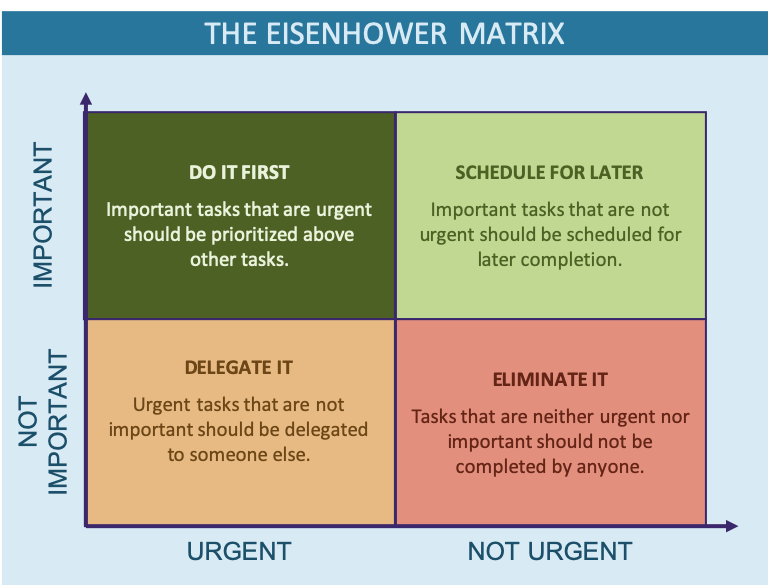The Eisenhower Matrix prioritization tool helps people decide what to work. It does this assessing the urgency and importance of their tasks. Tasks identified as important and urgent are done first. Important but non-urgent tasks are done later. Urgent & unimportant tasks are delegated and non-urgent and unimportant tasks are eliminated.
Summary by The World of Work Project
A Podcast
The Eisenhower Matrix Prioritization Tool helps people improve their personal effectiveness. You can learn more about personal effectiveness more broadly it in our podcast on the topic:
The Eisenhower Matrix Prioritization Tool
This tool is a four-box, 2×2 matrix model that to help with the prioritization of tasks.
To use it, individuals consider the importance of a task on the vertical axis and the urgency of a task on the horizontal axis. You should do tasks that are both urgent and important first. And you should schedule tasks that are important but not urgent for a later time. As for your tasks which are urgent but unimportant, you should delegated them as much as possible. Finally, you should eliminate (not do at all) those tasks which are neither urgent nor important.

The World of Work Project View
The Eisenhower Matrix Prioritization Tool is a useful way of thinking about things, and a useful tool for certain people.
Task focused people often benefit from reviewing their to-do list first thing in the morning to decide what to work on. If you’re the type of person who does this, you might benefit from using the Eisenhower Matrix as it provides a structure for the prioritization activity, and results in a clear plan of action for the day ahead.
In practice, there are some challenges with the model when you’re managing not just yourself, but a range of stakeholders. Specifically, challenges often arise around importance.
Things that are important for one person in the world of work may not be important for another. Something your customer wants may appear more “important” than something your supplier wants. But prioritizing between these two stakeholders is a judgement call. Making these judgement calls sometimes creates a division between what is good for the overall organization, and what is good for the individual making the decision.
Despite this challenge, this is a good tool that’s worth experimenting. If you try it, you might find it’s helpful for you.
How We Help Organizations
We provide leadership development programmes and consulting services to clients around the world to help them become high performing organizations that are great places to work. We receive great feedback, build meaningful and lasting relationships and provide reduced cost services where price is a barrier.
Learning more about who we are and what we do it easy: To hear from us, please join our mailing list. To ask about how we can help you or your organization, please contact us. To explore topics we care about, listen to our podcast. To attend a free seminar, please check out our eventbrite page.
We’re also considering creating a community for people interested in improving the world of work. If you’d like to be part of it, please contact us.
Sources and Feedback
This post on The Eisenhower Matrix Prioritization Tool is based on original work attributed to former American president Dwight D. Eisenhower, but we have no specific academic references for further reading.
We’re a small organization who know we make mistakes and want to improve them. Please contact us with any feedback you have on this post. We’ll usually reply within 72 hours.






